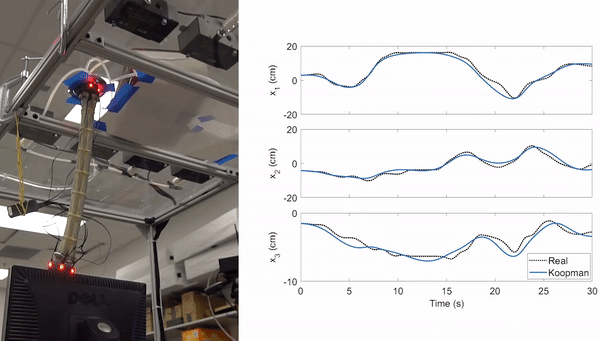It is difficult to precisely control soft robots due to the challenge of constructing models that are amenable to model-based control design techniques. Koopman operator theory offers a way to construct linear embeddings of soft robot dynamics that are compatible with established linear model-based control methods. I utilize such linear embeddings to control soft pneumatic robot arms, demonstrating previously unachievable performance capabilities such as trajectory following and automated object sorting. [rss2019] [tro2020] [icra-ral2021] [iros-ral2021] [ijrr2024_residual]


Soft robots are challenging to model due to their many degrees of freedom and nonlinear material properties. However, their soft bodies make it possible to safely observe their behavior under random control inputs, making them amenable to large-scale data collection and system identification. I utilize Koopman operator theory to identify dynamical models of soft robots via linear regression on observed data. Unlike other data-driven methods such as deep learning, my approach yields an explicit control-oriented linear model rather than just a "black-box" input-output mapping. [icra2019]
Robotics offers biologists a powerful tool for experimentally evaluating evolutionary hypotheses. Robots that are designed to mimic specific biological traits allow the fitness of those traits to be assessed via controlled experiments and can even be used to test the fitness of theoretical and extinct traits. In collaboration with the University of Michigan's Department of Ecology and Evolutionary Biology, I am developing biomimetic snake robots in an effort to better understand the adaptations snakes use to deter predators. [icra2020]


Fiber-reinforced soft actuators are a class of fluid-driven actuators composed of a deformable elastomeric skin and reinforcing fibers arranged to produce desired motions under volumetric expansion. They are particularly well suited for soft robotic applications because they can impart spatial forces without imposing a rigid structure and are highly customizable. I developed a novel methodology to represent and calculate the forces generated by arbitrary parallel combinations of these soft actuators as a linear function of internal pressure. [icra2017] [jmr2018] [ral2018] [icra-ral2022] [iros2024]